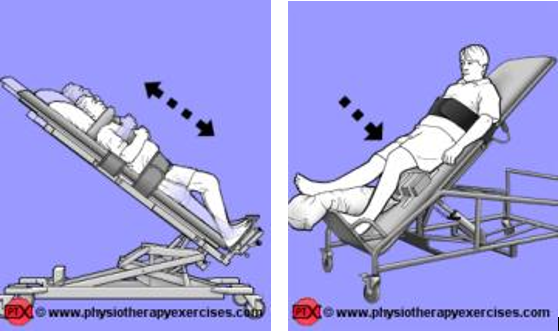 Someone said to me recently: “You know what is lacking in the literature – evidence for the use of tilt-table [in neuro rehabilitation]…”
Someone said to me recently: “You know what is lacking in the literature – evidence for the use of tilt-table [in neuro rehabilitation]…”
Hmm, I had to pause and think about the comment. In essence, we should ask to see the evidence for a specific intervention before choosing to use it in clinical practice. But I myself have not come across any papers that looked specifically at the tilt-table and yet, it is my favorite equipment to use in the rehab gym.
I replied: “Maybe… but there is strong evidence for intensive, high-reps and task-specific interventions. And on the tilt-table, patients can do heaps of squats, knee control exercises which are specific for standing up and walking.” (This study was in my mind: http://www.plosone.org/article/info%3Adoi%2F10.1371%2Fjournal.pone.0087987)
I could have also added the fact that the tilt-table tilts and slides, which means it uses the principles of “eliminating gravity” and “reducing friction” to allow the strengthening of very weak muscles (i.e., MMT grade 1 or 2). And of course, there are other reasons why clinicians would use the tilt-table such as
- increase arousal
- address orthostatic hypotension
- increase cardiorespiratory function
- increase muscle length (debatable)
- increase bone mineral density (debatable)
(The last 2 points are debatable due to this study: https://www.sciencedirect.com/science/article/pii/S0004951405700064)
All in all, despite the lack of specific evidence on the efficacy of the tilt-table, I think it’s one of the best equipment to have around due to the benefits listed, and its cost/affordability (compared to other fancy gadgets). With the tilt-table, semi-supervised practice is much more possible. Patients can carry out their exercises with minimal/no assistance. As long as they are well set-up with targets and counters, they can monitor their own performance and track their own progress which will also help them to take charge of their own rehabilitation. Therapists can also walk away and attend to other patients, knowing that the patient (on the tilt-table) is safe and working at a high intensity (i.e., achieving hundreds of reps) without them. A win-win situation on all fronts for both therapist and patient!
